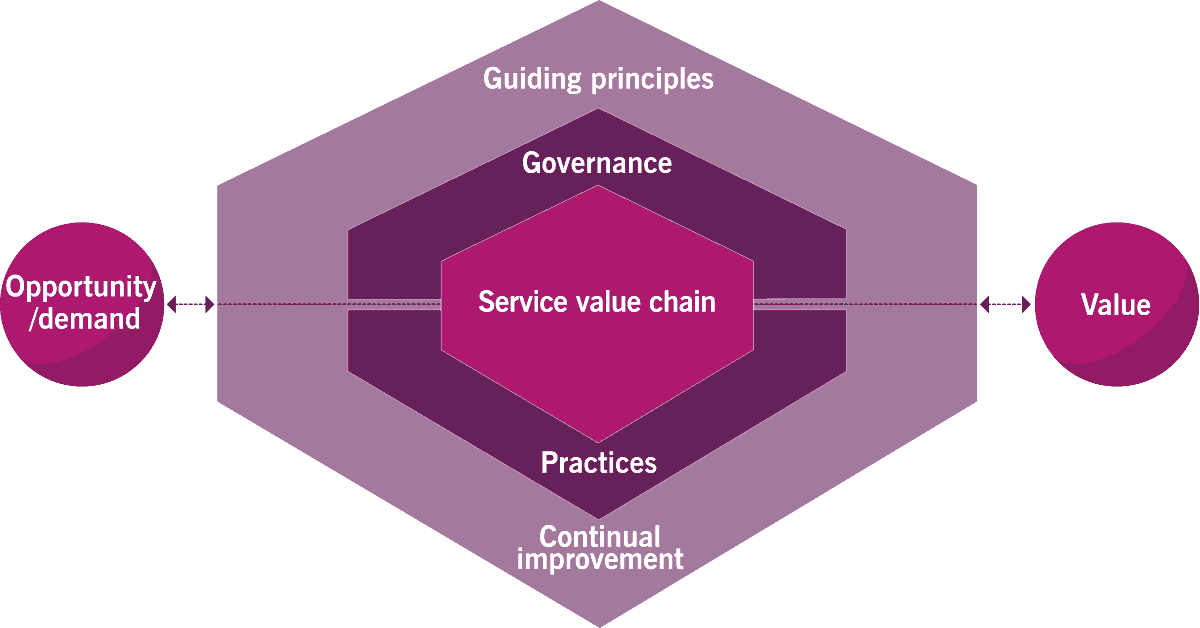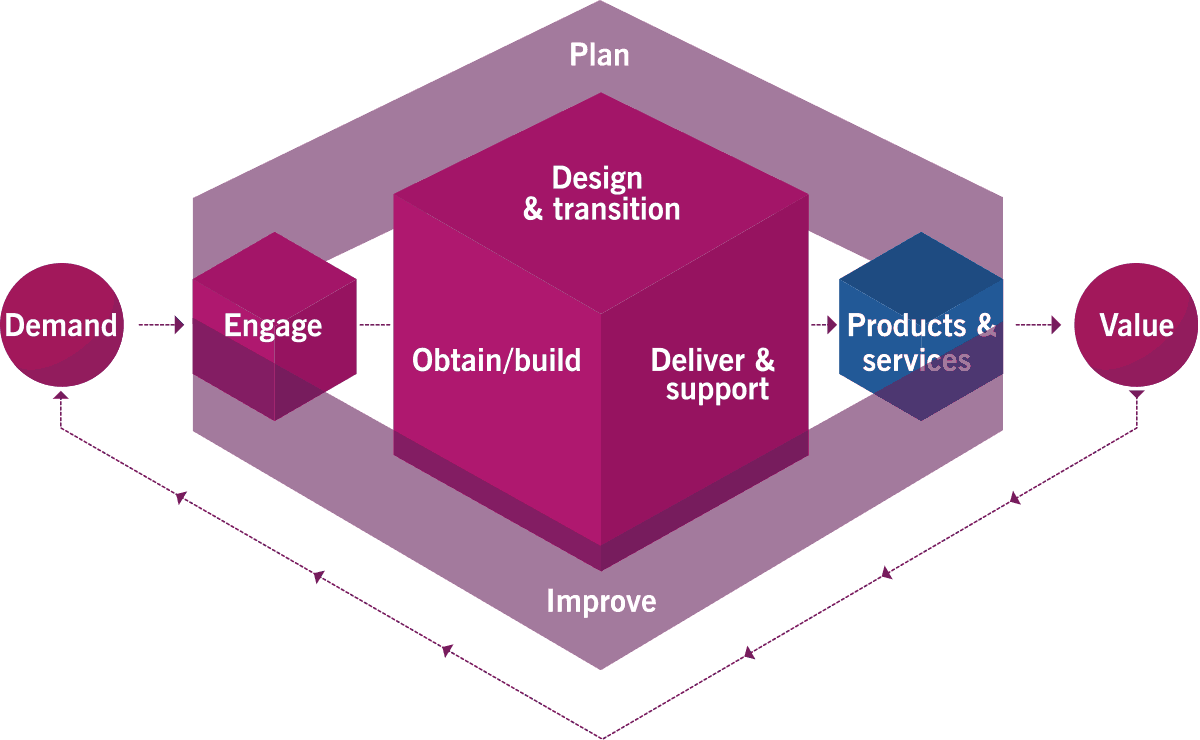Let’s talk about the ITIL 4 service value system. You might have noticed that ITIL v3 was “superseded” by ITIL 4 in 2019 with the release of the ITIL 4 Foundation publication. Much has changed and thus there’s a lot to get one’s head around – starting with the ITIL 4 service value system.
This article quickly explains what the ITIL 4 service value system is and what it contains across the ITIL 4 service value system itself, the ITIL guiding principles, the ITIL 4 service value chain, and the ITIL management practices.
The ITIL 4 service value system
So what’s that ITIL 4 service value system? Sometimes it’s best to use the words “straight from the horse’s mouth” – Axelos in this instance – with the ITIL 4 Foundation publication stating the following about the ITIL 4 service value system:
“The ITIL service value system describes how all the components and activities of the organization work together as a system to enable value creation. Each organization’s service value system has interfaces with other organizations, forming an ecosystem that can, in turn, facilitate value for those organizations, their customers, and other stakeholders.”
Source: Axelos, “ITIL Foundation: ITIL 4 Edition” (2019) – ITIL 4 service value system
Although – and oh how I’m full of idioms today – sometimes a picture paints a thousand words. So, here’s what the ITIL 4 service value system looks like:
The ITIL 4 Service Value System

Source: Axelos, “ITIL Foundation: ITIL 4 Edition” (2019) – ITIL 4 service value system
And it’s at this level that we can start to see how service providers (IT or otherwise) can use the combination of the following five elements in the ITIL 4 service value system to create the aforementioned value from stakeholder demand:
- Guiding principles
- Governance
- Service value chain
- Management practices
- Continual improvement.
Of these, it’s elements 1, 3, and 4 of the ITIL 4 service value system that probably require a little more explanation to those who are new to ITIL 4.
The guiding principles in the ITIL 4 service value system
If you were one of the clever people who read the 2016 ITIL Practitioner Guidance book, then the notion of guiding principles in the ITIL 4 service value system won’t be new to you. If they are new to you:
“A guiding principle is a recommendation that guides an organization in all circumstances, regardless of changes in its goals, strategies, type of work, or management structure.”
Source: AXELOS, “ITIL Foundation: ITIL 4 Edition” (2019)
And ITIL offers up seven guiding principles (as part of the ITIL 4 service value system):
- Focus on value
- Start where you are
- Progress iteratively with feedback
- Collaborate and promote visibility
- Think and work holistically
- Keep it simple and practical
- Optimize and automate.
If you’d like to read more on these and their place in the ITIL 4 service value system (and you don’t have the ITIL 4 Foundation book), I suggest that you read Stuart Rance’s blog: “The 7 Guiding Principles of ITIL 4: Practical Advice to Help You Make Decisions.”
The ITIL 4 service value chain
Again, let’s start with what Axelos – or at least the ITIL 4 authors – has to say about the service value chain that sits at the heart of the ITIL 4 service value system:
“The central element of the service value system is the service value chain, an operating model which outlines the key activities required to respond to demand and facilitate value realization through the creation and management of products and services.”
Source: AXELOS, “ITIL Foundation: ITIL 4 Edition” (2019) – ITIL 4 service value chain
Again, let’s look at the ITIL 4 service value system’s composition:
The ITIL 4 Service Value Chain

Source: Axelos, “ITIL Foundation: ITIL 4 Edition” (2019) – ITIL 4 service value chain
With the ITIL 4 Foundation publication content on the ITIL 4 service value system and service value chain stating that:
“The six value chain activities are:
- Plan
- Improve
- Engage
- Design and transition
- Obtain/build
- Deliver and support.
These service value chain activities in the ITIL 4 service value system represent the steps an organization takes in the creation of value. Each activity transforms inputs into outputs. These inputs can be demand from outside the value chain or outputs of other activities. All the activities are interconnected, with each activity receiving and providing triggers for further action.”
To help with the ITIL 4 service value system, you can read more on the ITIL service value chain in Daniel Breston’s recent article: “The ITIL 4 Service Value Chain Explained.”
ITIL 4’s management practices in the ITIL 4 service value system
ITIL v3’s IT service management (ITSM) guidance on processes has shifted to management practices in ITIL 4 (and I’ve just realized that I‘ve yet to state that ITIL 4 now talks to service management, not ITSM) which is important to understand in the context of the ITIL 4 service value system.
As to what these management practices in the ITIL 4 service value system are, Axelos states:
“In ITIL, a management practice is a set of organizational resources designed for performing work or accomplishing an objective. The origins of the practices are as follows:
- General management practices have been adopted and adapted for service management from general business management domains.
- Service management practices have been developed in service management and ITSM industries.
- Technical management practices have been adapted from technology management domains for service management purposes by expanding or shifting their focus from technology solutions to IT services.”
As an example of these, the 17 service management practices in the ITIL 4 service value system are:
- Availability management
- Business analysis
- Capacity and performance management
- Change control
- Incident management
- IT asset management
- Monitoring and event management
- Problem management
- Release management
- Service catalog management
- Service configuration management
- Service continuity management
- Service design
- Service desk
- Service level management
- Service request management
- Service validation and testing
You’ll notice some changes from the ITIL v3/2011 process titles as well as new areas of focus that recognize the ITIL 4 service value system.
So that’s my quick explanation of what the ITIL 4 service value system is. What else would you like to know about the ITIL 4 service value system or any of its parts? Or if you have issues with the ITIL 4 service value system. Please let me know in the comments.
This 2019 ITIL 4 service value system article was updated in 2023.
If you liked this ITIL 4 service value system article, the following ITIL-related articles are also very popular with ITSM.tools readers:
If you can’t find anything helpful here, please use the site’s search capability to find more interesting ITSM and ITIL articles.
Sophie Danby
Sophie is a freelance ITSM marketing consultant, helping ITSM solution vendors to develop and implement effective marketing strategies.
She covers both traditional areas of marketing (such as advertising, trade shows, and events) and digital marketing (such as video, social media, and email marketing). She is also a trained editor.


One Response
It’s a great summary. The challenge is getting people to map the value stream and identity the activities in the value chain.
I think the lack of practical examples for this, e.g., lack of workshops, no ‘ah ha’ moments to move it into broad practice (yet).